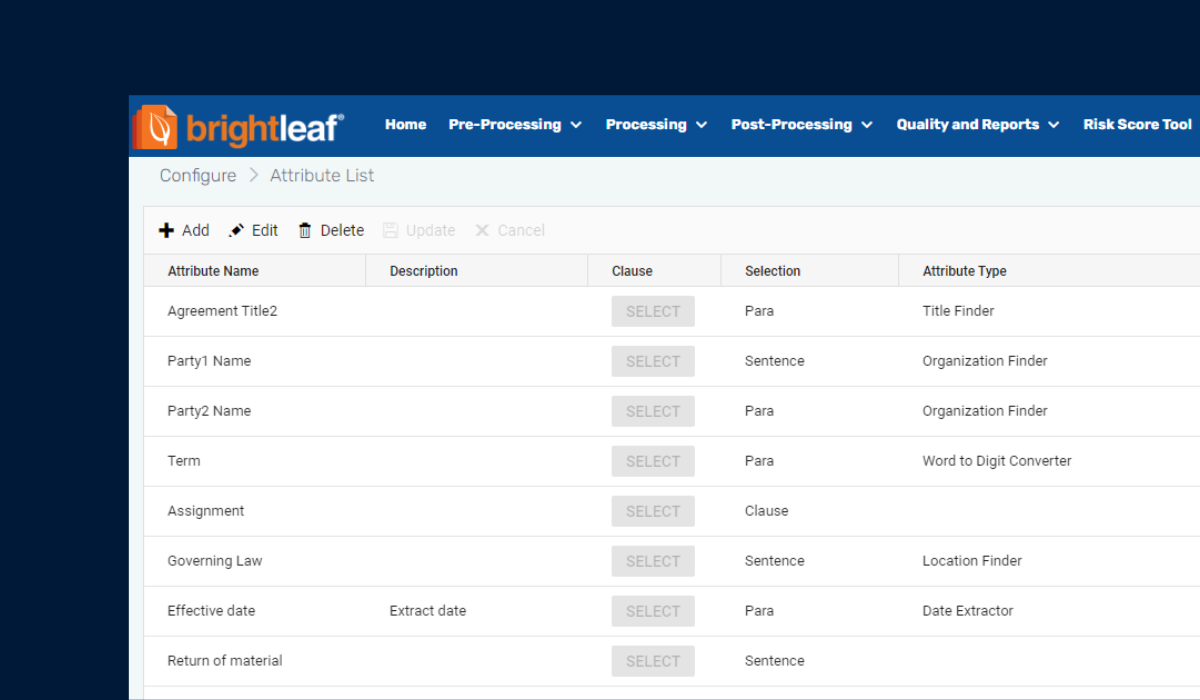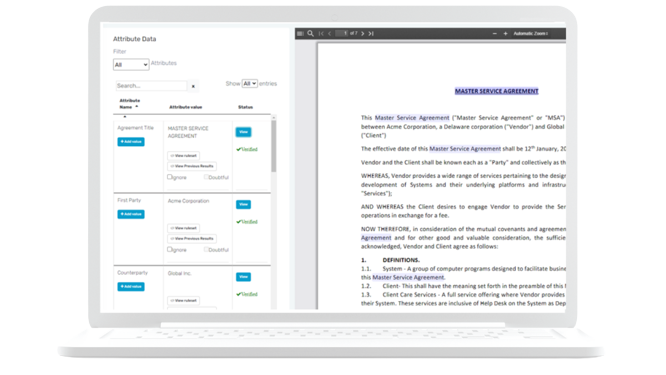
About Us
Turn contracts into strategic advantage
Manage contracts and risks by extracting information from their most important documents. Analyze contracts and extract/track all meta-data elements, clauses/provisions, obligations, and any custom attribute, Brightleaf provides an insight that is crucial to any company function.
Brightleaf’s third-party paper data extraction AI software can be licensed by companies as SaaS software for quick and effortless extraction of information from their ongoing contracts. The extraction engine has also been integrated into CLM systems for Third-Party Paper data extraction and legal review.
Our Offerings
Minimize contract risk while leveraging opportunities
Legacy Contract Data Extraction Service
Brightleaf extracts information from its clients’ legacy contracts using its own proprietary semantic intelligence/NLP technology, a team of lawyers, and a Six-Sigma process.
Brightleaf AI Data Extraction Software
The software OCRs the contracts, de-duplicates documents, creates a hierarchy, and extracts 100s of pre-configured attributes. Configurable to extract any specific data point from any contract type.
API for AI Data Extraction Software
The API can integrate with enterprise applications, like a CLM, to extract data from contracts. The software comes with hundreds of pre-configured attributes and has the ability to configure any custom attribute.
Extract Perfection
Brightleaf’s semantic intelligence engine is a proprietary software platform for analyzing and abstracting any and all commercial terms, legal provisions, and obligations from any legal document. The process of migration starts either from an old contract management system or a repository; or from scratch i.e. from paper documents to a new advanced CLM.
Powerful data extraction with 99.9999% accuracy
Want to minimize contract risk while increasing and leveraging opportunity? You need to know everything important in all your contracts – paper and digital – so you can inquire and report for timely response.


Resources
From CEO's desk
A 10-blog series on legacy contract data migration and extraction. Keep reading to learn more about the prevailing question that often arises while handling the contracts, tracking the salient terms and data points, creating templates for contract types and clause libraries, workflows, etc
Partnership
Together supporting global businesses
Brightleaf works with all the leading CLM companies in the industry and the implementation and consulting partners to enable clients to load accurate legacy contract data into their systems. This enables the clients to have a successful roll-out of the system and use the data effectively for reporting, dashboards, and triggers.

Your data is secure
Brightleaf affirms its commitment to securing its client’s sensitive information and delivering peak-quality service by driving continuous improvements to its products, services, and internal processes.

BBrightleaf is devoted to ensuring the security and privacy of its customers’ data. SOC 2 is an auditing procedure that ensures companies manage client data with the utmost security and privacy.

Brightleaf has built a stringent Information Security and Management System in compliance with ISO/IEC 27001:2013 standards to protect client data.

Brightleaf’s information security management system is fully GDPR compliant. Our projects are audited regularly to ensure compliance with our security and privacy management methods and applicable regulations.

Brightleaf’s information security system is audited for HIPAA compliance in order to protect any sensitive patient health information (PHI) that Brightleaf extracts.
AI-Powered Technology
Do you know what's in your contracts?
The importance of a robust contract management system is often overlooked until a company suffers financial losses, missed opportunities, or missed milestones as a result of sloppy contract management. It is crucial for businesses to have a thorough understanding of their contracts and a firm grasp on the meta-data contained inside them. Understanding contract terms such as payment terms, liability clauses, termination clauses, and more can help prevent misunderstandings or disputes down the road should something unexpected arise. A clear understanding of what is included in your contract can ensure that all parties involved are aware of their rights and responsibilities within the agreement.
Questions you might have
Need more help? Check out our FAQ section
What is abstraction/extraction and why do I need it?
Extraction is the process of pulling out relevant data points from contractual documents. Once these are extracted and labeled accordingly, they can be put into a structured database (even Excel) for further reporting and analysis.
For example, you can extract the Entity name, Counterparty, Expiration date, Autorenewal (Y/N), Workers Comp insurance liability limit (currency), etc.
Reports on these can be done once put into a structured database. For Example, “Give me the names of the Counter Party which have a Workers Comp liability limit of less than $1,000,000, etc.
Why do I need extraction?
There are multiple reasons for extraction. At a 60,000-foot level, you need to know easily what is in your contracts. Having the relevant information at your fingertips through reports in a structured database gets you all the information without you having to open each and every document to determine which meets the profile of your query. Some of the reasons for extraction are:
- Information – Much knowledge of the old contracts. This is lost if it is not in a new CLM
- Reporting – can do triggers of contracts coming up for renewal, supplier contracts with penalty clauses, etc.
- Adoption – CLM system is adopted if all the current and older contracts are in the new system along with the relevant data. (Important to note that it is not simply a document repository)
- Revenue recovery – police penalty clauses, etc.
- Compliance – track items that would be affected by changes in regulation
What is the difference between extraction and abstraction?
Even though there’s a difference in the dictionary meaning we use these two terms synonymously. As per the dictionary – extraction means the exact phrase from the contract/document is picked and copied whereas abstraction is the iota of extracted data.
For example, for the expiration date attribute, if the contract says “This contract expires on 3/4/19”, the extraction value for this would be “This contract expires on 3/4/19” whereas the abstraction value will be “3/4/19”, removing the irrelevant part from the phrase.
What is the difference between structured, semi-structured and unstructured data?
Data can be defined as a set of qualitative and quantitative values, that can be further processed to derive meaningful information. The quality of the information derived from a set of data depends on the accuracy and completeness of the data. It can further be divided into three types:
- Structured data – Data that has consistent formats and can be easily organized into a database like facts and figures entered into a pre-defined format or well drafted reports.
- Semi-structured data – The information that doesn’t reside in a pre-defined data format but does have some organizational properties that make it easier to analyze, for example, excel reports that do not conform to a formal structure.
- Unstructured data –Refers to information that either does not have a pre-defined data format and/or it is not organized using a common layout. Examples of unstructured data can be word docs, PDFs, video files, presentations, emails etc.
What are the different classifications of data?
Broadly data can be classified into five categories:
- Text – It includes script characters and expressions (words and sentences), like text written in different languages
- Numeric – Numeric values consist of numbers, decimal, percentage values, etc.
- Currency – This data type consists of monetary values like $ (US Dollar), € (Euro), ¥ (Yen), etc.
- Date & Time – It includes value for the years and time written in different formats like AM/PM, for dates 20th June 1990, 20/06/1990 (dd/mm/yyyy), 06/20/1990 (mm/dd/yyyy).
- Boolean Expressions – it indicates true/false, yes/no or on/off values.
What is legacy data and why it is important to track it?
Legacy data is data from your legacy or your executed contracts. These are contracts that have been executed by both parties. They may be current and still relevant or may have expired. It is important to track legacy data for the following reasons:
- Information – Much knowledge is stored in the old contracts which may be applicable to future business decisions. This is lost if it is not in a CLM.
- Reporting – can run triggers on contracts coming up for renewal, or supplier contracts with penalty clauses, etc.
- Adoption – CLM system is adopted if all the current and older contracts are in the new system
- Revenue recovery – police penalty clauses, etc.
- Compliance – track items that would be affected by changes in regulation
To know more read our whitepaper on 7 Reasons to Load Legacy Contracts









